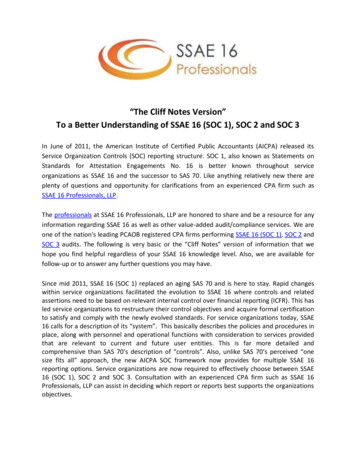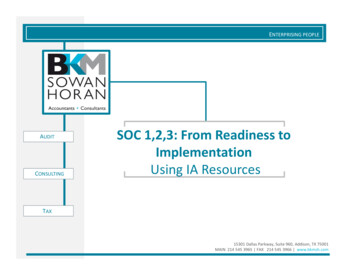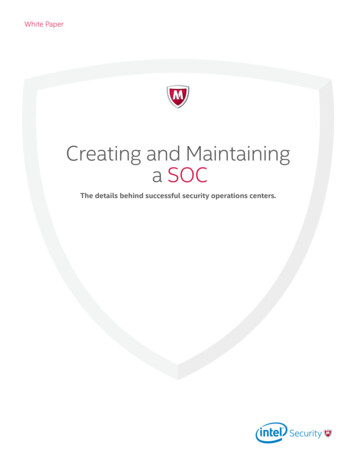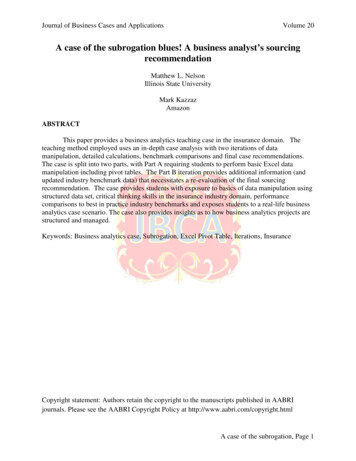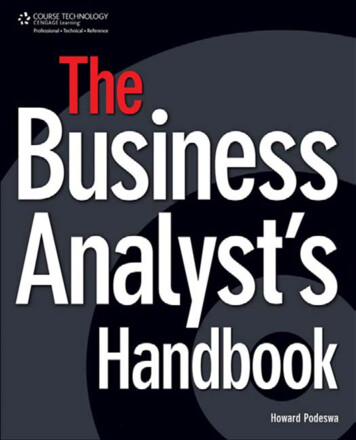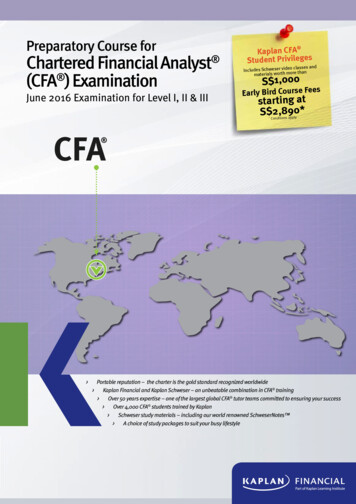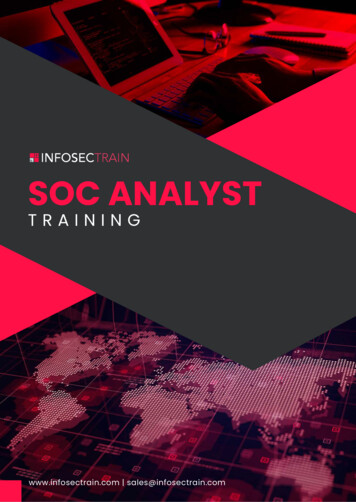
Transcription
SOC ANALYSTTRAININGwww.infosectrain.com sales@infosectrain.com
SOC ANALYST - TRAININGYou start hereLEARNING PATHSOC Analyst - Tools GoPhish Volatility Dirbuster Sqlmap Splunk Enterprise Maltego OSSIM Keepnote Wireshark Brup Suite Hashcat Hashclc SysInternals suite FTK ImagerDomain 1: Security Operations CentreDomain 2: Digital ForensicsDomain 3: Incident Response DomainDomain 4: Threat Intelligence DomainCertified SOC Analyst Expert
Course DescriptionThe Certified SOC analyst training program ismeticulously designed by the subject matterexperts at Infosec Train. The training programoffers a deep insight into the SOC operationsand workflows. It is an excellent opportunityfor aspiring and current SOC analysts(L1/L2/L3) to level up their skills to mitigatebusiness risks by effectively handling andresponding to security threats.www.infosectrain.com sales@infosectrain.com01
ObjectiveOur Certified SOC Training Program will help you tomaster over trending and in-demand technicalskills. The program starts with intermediate-levelcybersecurity concepts and then proceeds toadvanced forensic, threat Intelligence, Securityincident, and Event Management Solutions. InfosecTrain’s SOC Training Course provides cybersecurityprofessionals with advanced security skills andcertification. The training program will allow you to:Perform technical strategies, tools, and techniques to secure datafor your organization.Understanding the threats and providing countermeasures.Understand network forensics and incident response in depth.Cybersecurity industry knowledgeAnalyze and Classify Malwarewww.infosectrain.com sales@infosectrain.com02
Why Certified SOC analyst?SOC Analyst Certification serves as a launchpad for developingsecurity professionals. Its demand is continuously increasing inthe industry. The certified SOC analyst certification will not onlyenhance your knowledge on various SOC operations but will also:Help you to showcase your skills and working experience for the SOC Analyst jobpositionProvide you opportunities to secure a job in the other network security-relateddomainsKeep you updated with the latest skills necessary for L1/L2/L3 SOC Analyst jobpositionsEnable you to demonstrate to employers that you are committed to professionalgrowth and you are better equipped with skills to carry out complex tasks withinthe SOC teamwww.infosectrain.com sales@infosectrain.com03
PrerequisitePrior knowledge of Basic Networking knowledge,OS basics, Troubleshooting is recommendedExperience as an entry-level SOC Analyst, CyberSecurity Analyst Information Security roleExperience of two years in the Information SecuritydomainTarget AudienceTechnical Support EngineersSystem AdministratorSecurity ConsultantsCyber Security AnalystSecurity Systems EngineersSOC Analysts (Tier I and Tier II)www.infosectrain.com sales@infosectrain.com04
SOC ANALYSTTOOLS GoPhish Volatility Dirbuster Sqlmap Splunk Enterprise Maltego OSSIM Keepnote Wireshark Brup Suite Hashcat Hashclc SysInternals suite FTK ImagerOSSIMwww.infosectrain.com sales@infosectrain.com05
Domain 1: Security Operations CentreIntroduction to SOCAlienVault OSSIM fundamentals Building a successful SOC Functions of SOC AlienVault fundamentals and architecturedeployment Heart of SOC- SIEM Vulnerability scanning & monitoring with OSSIM Gartner’s magic quadrant SIEM guidelines and architectureIntroduction to QRadarELK Stack: IBM QRadar SIEM component architecture anddata flows Introduction and an overview of Elastic SIEM Using the QRadar SIEM User Interface User interface How to as a part of alert investigations orinteractive threat hunting MDR vs. Traditional SIEM; and other varioussolutions Elasticsearch: Understanding of Architecture, curator fundamentals Index template for routing, mapping KIBANA: Configuration, policies, visualization Deep-dive of Log architecture, parsing,alertsSecurityOnion What is Security Onion? Monitoring and analysis tools Security Onion Architecture Deployment types Installing a Standalone server: checkingsystem services with sostat, security onion withweb browser tools, security onion terminal Replaying traffic on a standalone serverSplunk In-Depth Industrial requirements of Splunk invarious fieldsFun with logs Working with offense triggered by events Working with offense triggered by flowsMonitoring Monitor QRadar Notifications and errormessages. Monitor QRadar performance Review and interpret system monitoringdashboards. Investigate suspected attacks and policybreaches Search, filter, group, and analyze security dataTools exposure provided inthe above section: SecurityOnion ELK Stack SGUILD Wireshark Splunk AlienVault OSSIM IBM Qradar CE Splunk terminologies, search processinglanguage, and various industry use caseswww.infosectrain.com sales@infosectrain.com06
Domain 2: Digital Forensics1: Introduction to Incident Response Section Introduction What is Digital Forensics?- Collecting evidence typically related to cybercrime Digital Subject Access Requests Computer Forensics Process- Identification, Preservation, collection, examination, analysis, reporting Working with Law Enforcement- The difference between an internal security issue and one that requires external assistance2: Forensics Fundamentals Section Introduction Introduction to Data Representationhexadecimal, octal, binary files vs. txt files, timestamp formats: UNIX epoch, MAC, Chrome,Windows, FILETIME Hard Drive Basics- Platters, sectors, clusters, slack space SSD Drive Basics- garbage, collection, TRIM, wear leveling File Systems- FAT16, FAT32, NTFS, EXT3/EXT4, HFS /APFS Metadata & File Carving Memory, Page File, and Hibernation File Order of Volatilitywww.infosectrain.com sales@infosectrain.com07
3: Evidence Forms Section Introduction Volatile Evidence- Memory RAM, Cache, Registers content, Routing tables, ARP cache, process table,kernel statistics, temporary filesystem/swap space Disk Evidence- Data on Hard Disk or SSD Network Evidence- Remotely Logged Data, Network Connections/Netflow, PCAPs, Proxy logs Web & Cloud Evidence- Cloud storage/backups, chat rooms, forums, social media posts, blog posts Evidence Forms- Laptops, desktops, phones, hard drives, tablets, digital cameras, smartwatches, GPS4: Chain of Custody Section Introduction What is the Chain of Custody? Why is it Important?- In regard to evidence integrity and examiner authenticity Guide for Following the Chain of Custody- evidence collection, reporting/documentation, evidence hashing, write-blockers,working on a copy of original evidence5: Windows Investigations Section Introduction Artifacts- Registry, Event Logs, Prefetch, .LNK files, DLLs, services, drivers, common maliciouslocations, schedules tasks, start-up files Limitations Example Investigationswww.infosectrain.com sales@infosectrain.com08
6: *nix Investigations Section Introduction Artefacts Limitations Example Investigations Artefact Collection- Section Introduction- Equipment- non-static bags, faraday cage, labels, clean hard drives, forensic workstations,Disk imagers, hardware write blockers, cabling, blank media, photographs- Tools- Wireshark, Network Miner, and others- ACPO Principles- Live Forensics- Fast acquisition of key files- How to Collect Evidence- Laptops, desktops, phones, hard drives, tablets, websites, forum posts, blogposts, social media posts, chat rooms- Types of Hard Drive Copies visible data, bit for bit, slackspace7: Live Forensics Section Introduction Live Acquisition- What is a live acquisition/live forensics? Why is it beneficial? Products- Carbon Black, Encase, memory analysis with agents, Custom Scripts Potential Consequences- Damaging or modifying evidence making it invalid8: Post-Investigation Section Introduction Report Writing Evidence Retention- Legal retention periods, internal retention periods Evidence Destruction- Overwriting, degaussing, shredding, wiping- Further Reading9: Tools exposure provided in the above section: Command-LINE for Windows / Linux FTK IMAGER MAGNATE RAM CAPTURE AUTOPSY Volatility Volatility WorkBench ENCASEwww.infosectrain.com sales@infosectrain.com09
Domain 3: Incident Response Domain1: Introduction to Incident Response What is Incident Response? Why is IR Needed? Security Events vs. Security Incidents Incident Response Lifecycle – NIST SP 800 61r2- What is it, why is it used Lockheed Martin Cyber Kill Chain- What is it, why is it used MITRE ATT&CK Framework- What is it, why is it used2: Preparation Incident Response Plans, Policies, and Procedures The Need for an IR Team Asset Inventory and Risk Assessment to Identify High-Value Assets DMZ and Honeypots Host Defences- HIDS, NIDS- Antivirus, EDR- Local Firewall- User Accounts- GPO Network Defences- NIDS- NIPS- Proxy- Firewalls- NAC Email Defences- Spam Filter- Attachment Filter- Attachment Sandboxing- Email Tagging Physical Defences- Deterrents- Access Controls- Monitoring Controls Human Defences- Security Awareness Training- Security Policies- Incentiveswww.infosectrain.com sales@infosectrain.com10
3: Detection and Analysis Common Events and Incidents Establishing Baselines and Behaviour Profiles Central Logging (SIEM Aggregation) Analysis (SIEM Correlation)4: Containment, Eradication, Recovery CSIRT and CERT Explained- What are they, and why are they useful? Containment Measures- Network Isolation, Single VLAN, Powering System(s) Down, Honeypot Lure Taking Forensic Images of Affected Hosts- Linking Back to Digital Forensics Domain Identifying and Removing Malicious Artefacts- Memory and disk analysis to identify artefacts and securely remove them Identifying Root Cause and Recovery Measures5: Lessons Learned What Went Well?- Highlights from the Incident Response What Could be Improved?- Issues from the Incident Response, and How These Can be Addressed Important of Documentation- Creating Runbooks for Future Similar Incidents, Audit Trail Metrics and Reporting- Presenting Data in Metric Form Further Reading6: Tools exposure provided in the above section: SYSINTERNAL SUITE Hash Calculator Online Sources CyberChef Wireshark Network Minorwww.infosectrain.com sales@infosectrain.com11
Domain 4: Threat Intelligence Domain1: Introduction to Incident Response3: Advanced Persistent Threats Section Introduction Threat Intelligence Explained- What is TI, why is it used Why Threat Intelligence can be Valuable- Situational awareness, investigation enrichment,reducing the attack surface Criticisms/Limitations of Threat Intelligence- Attribution issues, reactive nature, old IOCs,false-positive IOCs The Future of Threat Intelligence- Tenable Predictive Prioritization (mixing threatintel with vulnerability management data to calculate dynamic risk scores) Types of Intelligence- SIGINT, OSINT, HUMINT, GEOINT What are APTs?- What makes an APT?, Real-world examples of APTs their operations Motivations for Cyber Operations- Why APTs do what they do (financial,political, social) Tools, Techniques, Tactics- What do APTs actually do when conducting operations Custom Malware/Tools- Exploring custom tools used by APTs, whythey’re used Living-off-the-land Techniques- What LOTL is, why it’s used, why it can beeffectivev2: Threat Actors Common Threat Agents- Cybercriminals, hacktivists, insider threats,nation-states Motivations- Financial, social, political, other Skill Levels/Technical Ability- Script Kiddies, Hackers, APTs Actor Naming Conventions- Animals, APT numbers, other conventions Common Targets- Industries, governments, organizations12
4: Operational Intelligence6: Strategic Threat Intelligence Indicators of Compromise Explained & Examples- What IOCs are, how they’re generated and shared,using IOCs to feed defences Precursors Explained & Examples- What precursors are, how they’re different fromIOCs, how we monitor them TTPs Explained & Examples- What TTPs are, why they’re important, using tomaintain defences (preventative) MITRE ATT&CK Framework- Framework explained and how we map cyber-attacks, real-world example Lockheed Martin Cyber Kill Chain- Framework explained and how we map cyber-attacks, real-world example Attribution and its Limitations- Why attribution is hard, impersonation, sharinginfrastructure, copy-cat attacks Pyramid of PainYou’ll wish we didn’t teach you this. It’s called thePyramid of Pain for a reason. Intelligence Sharing and Partnerships- Why sharing intel is important,existing partnerships, US-CERT, NCCIC,NCSC, ISACs IOC/TTP Gathering and Distribution Campaign Tracking & SituationalAwareness- Why we track actors, why keepingthe team updated is important New Intelligence Platforms/Toolkits- Undertaking proof-of-value demosto assess the feasibility of new tooling OSINT vs. Paid-for Sources- Threat Intelligence Vendors, PublicThreat Feeds, National VulnerabilityDatabase, Twitter5: Tactical Threat Intelligence Threat Exposure Checks Explained- What TECs are, how to check your environment forthe presence of bad IOCs Watchlists/IOC Monitoring- What are watchlists, how to monitor for IOCs (SIEM,IDPS, AV, EDR, FW) Public Exposure Assessments- What PEAs are, how to conduct them, google dorks,harvester, social media Open-Web Information Collection- How OSINT data is scraped, why it’s useful Dark-Web Information Collection- How intel companies scrape dark web intel, why it’suseful, data breach dumps, malicious actors onunderground forums, commodity malware for sale Malware Information Sharing Platform (MISP)- What is MISP, why is it used, how to implement MISP7: Malware and Global Campaigns Types of Malware Used by ThreatActors- Trojans, RATs, Ransomware, Backdoors, Logic Bombs Globally recognized Malware Campaigns- Emotet, Magecart, IcedID, Sodinikobi,Trickbot, Lokibot8: Further Reading Further Reading Material- Links to more resources thatstudents
System Administrator Security Consultants Cyber Security Analyst Security Systems Engineers SOC Analysts (Tier I and Tier II) www.infosectrain.com sales@infosectrain.com 05 OSSIM GoPhish Dirbuster Splunk Enterprise OSSIM Wireshark Hashcat SysInternals suite Volatility Sqlmap Maltego Keepnote Brup Suite Hashclc FTK Imager SOC ANALYST TOOLS. Domain 1 .
